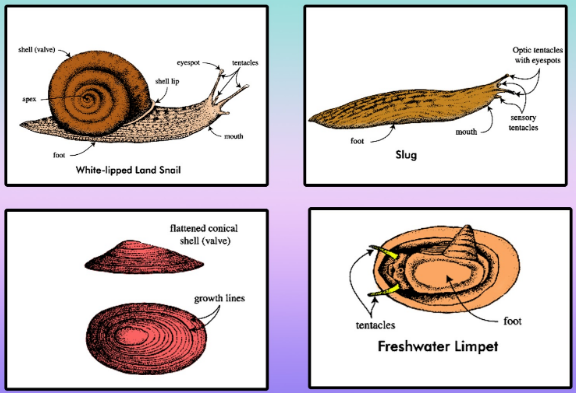
What are examples of Gastropods?
Answer
507.3k+ views
Hint: Gastropoda is a class that belongs to the phylum Mollusca. It is said to be the second-largest phylum of animals. The members of this class consist of a hard outer shell covering that shows a complete 180° rotation called torsion.
Complete answer:
This class Gastropoda contains over 35,000 living and 15,000 fossil gastropod species that comprise the largest class under the phylum and which includes the limpets, top shells, periwinkles, slipper shells, snails, slugs, sea hares, abalones, nudibranchs, or sea slugs, and sea butterflies. They include the marine, terrestrial as well as freshwater organisms. Their shell is generally found to be three-layered and made up of calcium carbonate with varied textures, shapes, sizes, and colors. They also consist of a tail with somebody inside the shell. The slugs are the members of this class but do not consist of a shell. The organisms of this class undergo torsion where the body of organisms is twisted such that the tail region comes towards the head region and all the internal organs are also twisted. It is retained in adults while might be lost in young ones.
Additional information:
1) This class includes three subclasses that are the Prosobranchia (a large number of gastropods), the Pulmonata (land snails), and the Opisthobranchia (sea hares and sea slugs).
2) Later subclass under the class Gastropoda is seen to consist of animals that have reduced shells or none at all, among them most gastropods are motile, but some are sedentary like the slipper shell ( Crepidula).
3) The reproductive structures are separate mostly and the mode of reproduction varies. Here the fertilization of eggs generally occurs inside the seawater. Here some gastropods are hermaphrodites (having both sexes in the same individual) in nature while some are protandric hermaphrodites, i.e., first, they are male later they become female after development.
4) Gastropods were described by Georges Cuvier in the scientific literature in 1795 which derives from the Ancient Greek word referring to the fact that the animal's "foot" is positioned below its guts.
So, the correct answer is, ‘Gastropoda’.

Note:
The class Gastropods are seen to be economically valuable as food for many animals, including humans, but some of the gastropods are serious pests; e.g: the common slug causes much garden damage.
Complete answer:
This class Gastropoda contains over 35,000 living and 15,000 fossil gastropod species that comprise the largest class under the phylum and which includes the limpets, top shells, periwinkles, slipper shells, snails, slugs, sea hares, abalones, nudibranchs, or sea slugs, and sea butterflies. They include the marine, terrestrial as well as freshwater organisms. Their shell is generally found to be three-layered and made up of calcium carbonate with varied textures, shapes, sizes, and colors. They also consist of a tail with somebody inside the shell. The slugs are the members of this class but do not consist of a shell. The organisms of this class undergo torsion where the body of organisms is twisted such that the tail region comes towards the head region and all the internal organs are also twisted. It is retained in adults while might be lost in young ones.
Additional information:
1) This class includes three subclasses that are the Prosobranchia (a large number of gastropods), the Pulmonata (land snails), and the Opisthobranchia (sea hares and sea slugs).
2) Later subclass under the class Gastropoda is seen to consist of animals that have reduced shells or none at all, among them most gastropods are motile, but some are sedentary like the slipper shell ( Crepidula).
3) The reproductive structures are separate mostly and the mode of reproduction varies. Here the fertilization of eggs generally occurs inside the seawater. Here some gastropods are hermaphrodites (having both sexes in the same individual) in nature while some are protandric hermaphrodites, i.e., first, they are male later they become female after development.
4) Gastropods were described by Georges Cuvier in the scientific literature in 1795 which derives from the Ancient Greek word referring to the fact that the animal's "foot" is positioned below its guts.
So, the correct answer is, ‘Gastropoda’.

Note:
The class Gastropods are seen to be economically valuable as food for many animals, including humans, but some of the gastropods are serious pests; e.g: the common slug causes much garden damage.
Recently Updated Pages
Why is there a time difference of about 5 hours between class 10 social science CBSE

Master Class 11 Social Science: Engaging Questions & Answers for Success

Master Class 11 Physics: Engaging Questions & Answers for Success

Master Class 11 Maths: Engaging Questions & Answers for Success

Master Class 11 Economics: Engaging Questions & Answers for Success

Master Class 11 Computer Science: Engaging Questions & Answers for Success

Trending doubts
What is meant by exothermic and endothermic reactions class 11 chemistry CBSE

Which animal has three hearts class 11 biology CBSE

10 examples of friction in our daily life

One Metric ton is equal to kg A 10000 B 1000 C 100 class 11 physics CBSE

1 Quintal is equal to a 110 kg b 10 kg c 100kg d 1000 class 11 physics CBSE

Difference Between Prokaryotic Cells and Eukaryotic Cells




